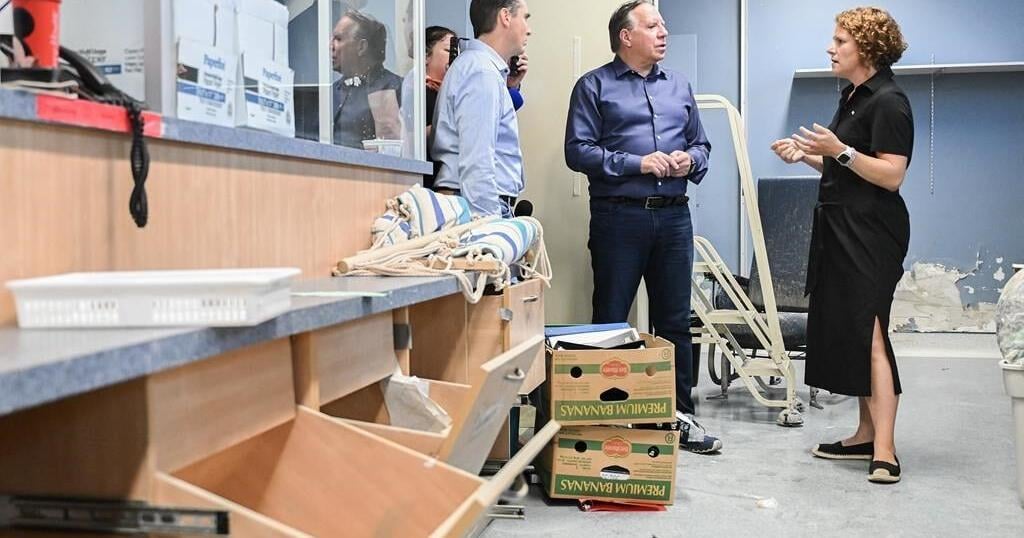MONTREAL – Nearly a week after torrential rain battered Quebec, the contents of people’s basements are spilling across their lawns as they wait for garbage trucks to cart away their waterlogged furniture and ruined belongings.
In Louiseville, a community of 7,000 people near the St. Lawrence River northeast of Montreal, Mayor Yvon Deshaies says people are doing their best to clean out their homes before mould sets in. About 300 basements in the municipality flooded, he said, some with up to four or five feet of water.
“This has never happened before,” he said. “It’s terrible.”
Further up the river, in nearby Yamachiche, Mayor Paul Carbonneau says garbage pickup continued until 10 p.m. on Wednesday. He’s hoping the cleanup will be finished on Friday for the roughly 100 homes that were flooded.
Now that the water has receded and the most urgent part of the crisis is over,Deshaies and Carbonneau — and many people across a large swath of the province that was hit by up to 200 millimetres of rain last Friday — are starting to worry about money. Who will help them pay to fix the damage?
During a visit to Louiseville on Thursday, Quebec Premier François Legault told reporters his top priorities after the storm were restoring power to the 550,000 customers left in the dark and fixing damaged roads that left hundreds of houses isolated. Now, though, “we’re dealing with money,” he said. “The problem that remains … is the question of financial compensation for people who were flooded.”
Legault suggested the province may temporarily expand its financial assistance program for disaster victims to include sewer backups, which have been excluded until now because they’re typically covered by private insurance. The government program has only compensated homeowners for water damage caused by overland flooding, but the premier said that needs to be revisited.
“Why was there a sewer backup? It’s because there was a flood,” he said. “So at a certain point you have to use common sense.”
Deshaies said he welcomes the possibility of more government aid. “I want everyone to be able to access the program,” he said, adding that he believes the government should pay the difference between private insurance coverage and the full cost of repairs. “I would like people not to lose money.”
Legault didn’t offer any details about how the program might be expanded or who would be eligible.
An expansion of the province’s disaster financial assistance fund would be a “major” change — and likely a very expensive one, said Alain Mailhot, a professor of urban hydrology at Quebec’s national scientific research institute.
“There’s a problem, I agree with the premier,” he said of the number of people dealing with sewer backups. “It’s not that you shouldn’t do it, but putting that into place seems like a big puzzle.”
Quebec’s disaster assistance program is already in high demand. A 2021 audit found a “considerable increase” in the number of applicants and in the amount of funds paid out in recent years. After heavy spring flooding in 2017, the program paid out $285 million to people in 293 municipalities across the province. That bill paled in comparison to the $426 million paid out after even worse flooding in 2019.
Last year, there were 35 weather events that left at least one Quebec community eligible for disaster assistance — more than any other year since at least 2010. Most of those involved heavy rainfall. So far this year, there have been 21 such events.
Many municipalities have had repeated episodes of rain and flooding in recent years. Nearly half of the 123 communities eligible for disaster assistance following Friday’s rainfall have been eligible for government funds at least five times since 2010. Fifteen of them have been on the list 10 times or more.
Louiseville and Yamachiche are among that group, though they’re most often hit by spring meltwater, not torrential rain. Mailhot said flooding is now happening more frequently following summer storms, rather than just during the spring thaw. “Climate models tell us that this kind of situation, unfortunately, risks happening more often,” he said.
Pascale Biron, a geography professor at Concordia University, said that in urban areas prone to sewer backups, cities can build sponge parks and green roofs to help absorb water and prevent sewers from overflowing. In the interim, she said, it’s “good news” for people dealing with sewer backups if the government decides to offer more money.
“I have a lot of sympathy for people who are in that situation, because they have zero control,” she said. “But on the other hand, I could see that if you open that can of worms, then that could be costly, because it really happens a lot.”
On Thursday, Legault had to defend himself for not having visited flood-stricken communities until almost one week after the record-breaking rainfall. Speaking to reporters for the first time since the storm, he said he’d been focused on the widespread power outages and washed-out roads in the first days after the rain. “I think I did what I had to do,” he said.
This report by The Canadian Press was first published Aug. 15, 2024.
